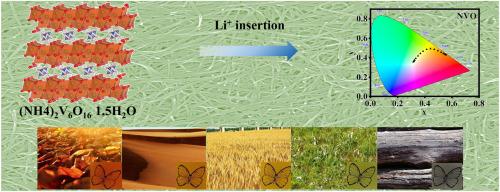Cation pre-inserted vanadium oxide nanobelts as multicolor electrochromic materials for adaptive camouflage
IF 6.3
2区 材料科学
Q2 ENERGY & FUELS
引用次数: 0
Abstract
V2O5 is a promising electrochromic material for adaptive camouflage or electronic display. However, it is still challenging to enable fast response time, multicolor change and good cyclic stability. In this paper, we successfully synthesized different cation (NH4+, K+ and Na+) pre-inserted vanadium oxide nanobelt films (NVO, KVO and NaVO) by stirring impregnation method. All nanobelts are composed of V3O8 layers with hydrated cations acting as pillars in the interlayer, exhibiting excellent electrochromic properties and remarkable multicolor changes. Among them, the NVO nanobelt films have the highest transmittance modulation (ΔT = 54 % at 510 nm and ΔT = 56 % at 950 nm), fastest response time (4.4 s for coloration time, 5.5 s for bleaching time at 422 nm and 6.8 s for coloration time and 7.7 s for bleaching time at 950 nm) and best stability (3000 cycles). Impressively, the NVO film is highly reversible between five colors: orange-red, orange, yellow, green and blue-grey, showing great breakthrough in adaptive camouflage application.

阳离子预嵌入氧化钒纳米颗粒作为多色电致变色材料用于自适应伪装
V2O5 是一种很有前途的电致变色材料,可用于自适应伪装或电子显示。然而,如何实现快速响应时间、多色变化和良好的循环稳定性仍是一项挑战。本文采用搅拌浸渍法成功合成了不同阳离子(NH4+、K+和Na+)预浸渍氧化钒纳米带薄膜(NVO、KVO和NaVO)。所有纳米带均由 V3O8 层组成,水合阳离子在层间起支柱作用,具有优异的电致变色性能和显著的多色变化。其中,NVO 纳米带薄膜具有最高的透射率调制(510 纳米波长下 ΔT = 54 %,950 纳米波长下 ΔT = 56 %)、最快的响应时间(422 纳米波长下着色时间为 4.4 秒,漂白时间为 5.5 秒;950 纳米波长下着色时间为 6.8 秒,漂白时间为 7.7 秒)和最佳的稳定性(3000 次循环)。令人印象深刻的是,NVO 薄膜在橘红色、橙色、黄色、绿色和蓝灰色五种颜色之间具有高度可逆性,在自适应伪装应用方面实现了重大突破。
本文章由计算机程序翻译,如有差异,请以英文原文为准。
求助全文
约1分钟内获得全文
求助全文
来源期刊

Solar Energy Materials and Solar Cells
工程技术-材料科学:综合
CiteScore
12.60
自引率
11.60%
发文量
513
审稿时长
47 days
期刊介绍:
Solar Energy Materials & Solar Cells is intended as a vehicle for the dissemination of research results on materials science and technology related to photovoltaic, photothermal and photoelectrochemical solar energy conversion. Materials science is taken in the broadest possible sense and encompasses physics, chemistry, optics, materials fabrication and analysis for all types of materials.
 求助内容:
求助内容: 应助结果提醒方式:
应助结果提醒方式:


